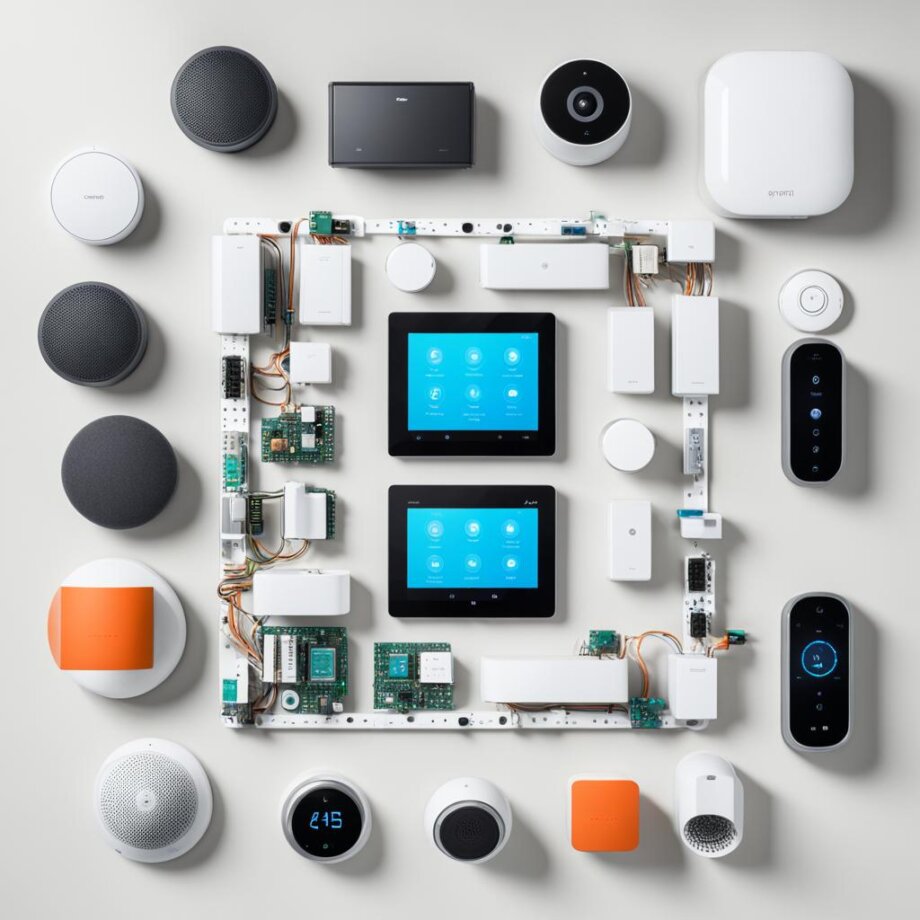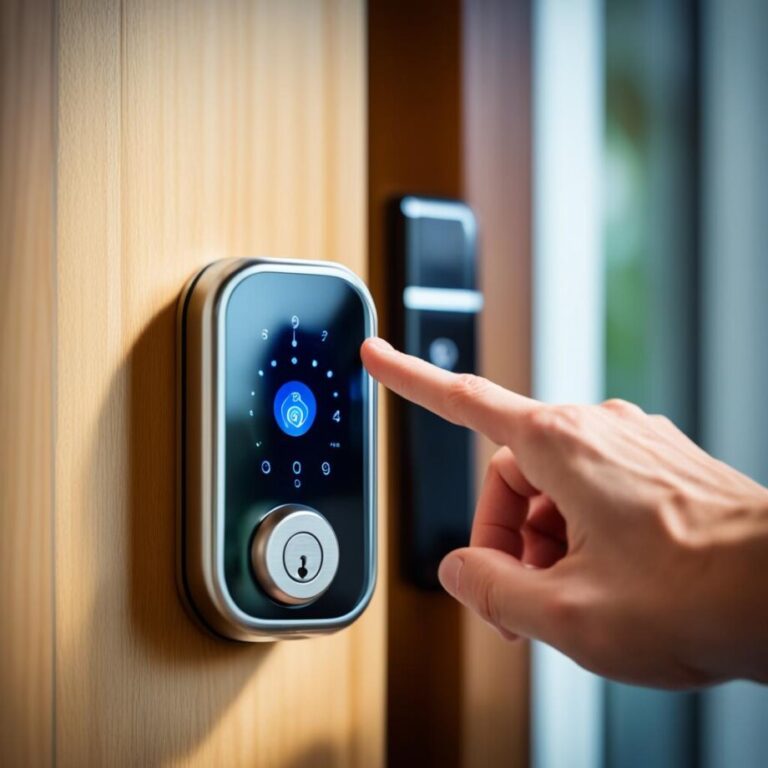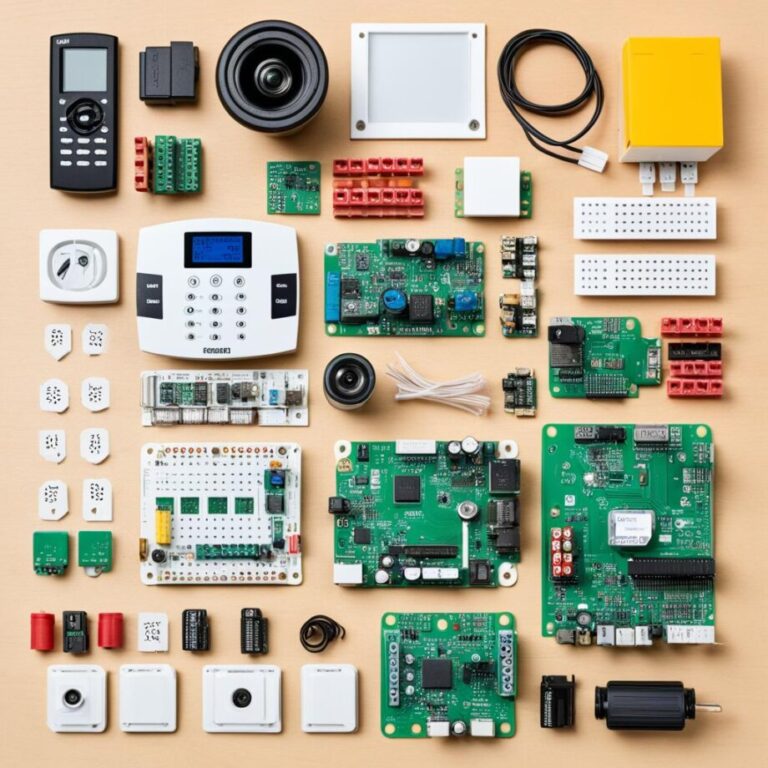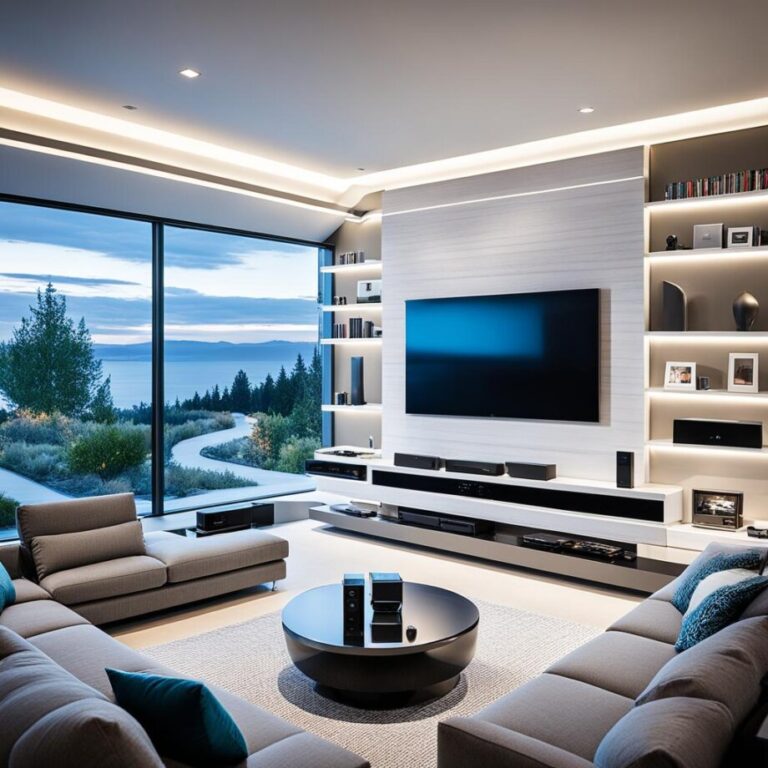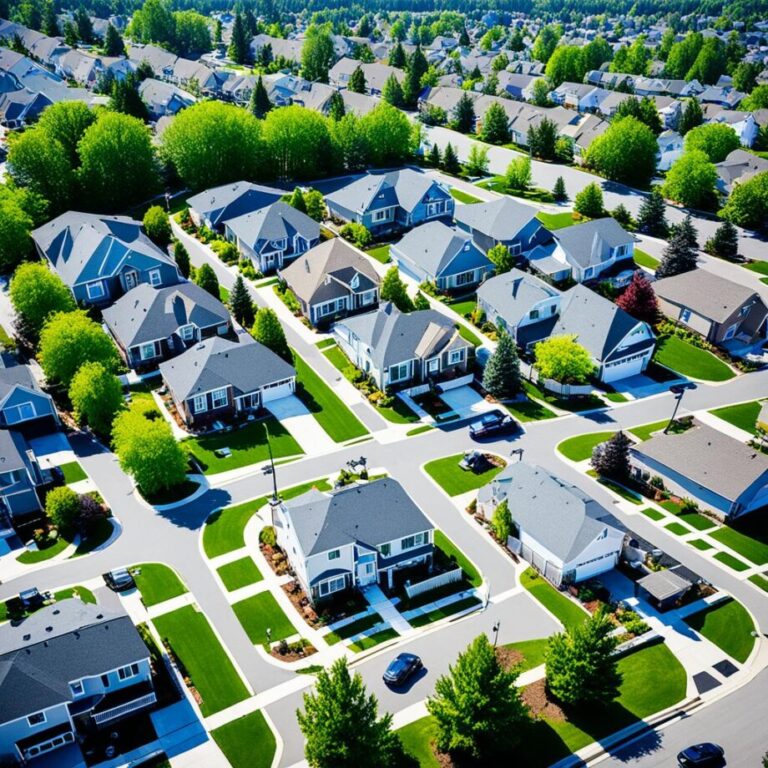Welcome to our comprehensive DIY guide to building a custom home automation system. Are you ready to transform your home into a smart haven where everything is just a tap away? Say goodbye to manual switches and hello to a world of convenience and efficiency. In this tutorial, we will walk you through the step-by-step process of creating your own smart home from scratch. Whether you’re a tech enthusiast or a beginner, this guide will empower you to automate your home and enjoy the benefits of a truly connected living space. So, are you ready to take control of your home and explore the endless possibilities?
In this DIY guide, we will cover everything you need to know about building a custom home automation system. From understanding the basics of home automation to choosing the right devices and setting up a central hub, we have you covered. You will learn how to optimize network connectivity and security, automate lighting and appliances, create a smart security system, enhance comfort and energy efficiency, and customize control and integration. So, whether you want to turn on the lights with a voice command or unlock your door remotely, get ready to transform your home into a smart oasis.
But first, let’s dive into the fundamentals of home automation and explore its endless possibilities. Are you ready to embark on a journey that will revolutionize the way you interact with your home? Let’s get started!
Understanding Home Automation
Welcome to the world of home automation! In this section, we will explore the concept of home automation and provide you with essential instructions on planning your project and setting up a smart home. Whether you’re starting from scratch or upgrading your existing system, understanding the fundamentals is crucial for a successful home automation journey. Let’s get started!
The Importance of Home Automation Project Planning
Before diving into the technical aspects of setting up a smart home, it’s essential to have a clear plan in place. Home automation project planning allows you to identify your goals, determine your budget, and select the right components for your system. By considering factors such as your lifestyle, preferences, and specific needs, you can create a customized automation setup that caters to your unique requirements.
During the planning phase, take the time to envision how you want your home automation system to function. Consider which areas you want to automate, such as lighting, security, climate control, or entertainment. This will help you map out the necessary devices and integrations, making the installation process smoother.
Smart Home Setup Instructions
Once you have a plan in place, it’s time to bring your smart home to life. To help you get started, we’ve compiled step-by-step instructions that will guide you through the setup process. Follow these instructions closely, and you’ll be well on your way to enjoying the convenience and comfort of a fully automated home.
- Begin by selecting a central hub: The central hub acts as the brain of your home automation system, allowing you to control and manage all your devices from one place. Choose a hub that is compatible with your desired devices and offers the features you need.
- Next, identify the necessary components: Depending on your automation goals, you may need devices such as smart switches, dimmers, sensors, cameras, and more. Make a list of the devices required for each automation category and ensure they are compatible with your chosen hub.
- Install and configure your devices: Follow the manufacturer’s instructions to install and configure each device. This may involve connecting them to your hub, setting up user accounts, and configuring automation routines or schedules.
- Test and troubleshoot: Once your devices are installed, test them to ensure they are functioning correctly. If you encounter any issues, consult the manufacturer’s troubleshooting guide or seek assistance from their support team.
- Expand your system: As you become more familiar with home automation, you can continue expanding your system by adding new devices and integrating additional features. This will allow you to create a comprehensive and fully customized automation setup.
By following these smart home setup instructions and taking the time to plan your project, you’ll be well-equipped to create an efficient and enjoyable home automation system. Now that you understand the basics, let’s move on to choosing the right devices for your setup.
Choosing the Right Devices
When it comes to building your own smart home, choosing the right devices is crucial for a seamless and efficient automation system. With a wide range of smart devices available in the market, it can be overwhelming to decide which ones will best suit your needs. In this section, we will guide you through the process of selecting the perfect devices for your custom home automation setup.
Types of Smart Devices
Smart devices come in various categories, each serving a specific purpose in automating different aspects of your home. Here are some of the key types of smart devices you should consider:
- Smart speakers and voice assistants: These devices, such as Amazon Echo or Google Home, allow you to control other smart devices using voice commands.
- Smart thermostats: These devices help you regulate temperature settings in your home, enhancing energy efficiency and comfort.
- Smart lighting: With smart bulbs and switches, you can easily control and automate your home’s lighting to create personalized atmospheres.
- Smart locks and security systems: These devices provide enhanced security features, allowing you to remotely monitor and control access to your home.
- Smart appliances: From smart refrigerators to washing machines, these devices offer additional convenience and energy-saving features.
It’s important to assess your needs and prioritize which areas of your home you want to automate. This will help you narrow down your choices and ensure that the devices you select align with your goals.
Compatibility and Integration
When selecting smart devices, compatibility and integration should be key considerations. Ensure that the devices you choose are compatible with your chosen automation platform and can seamlessly integrate with each other. This will enable you to control and manage all your devices through a single interface, enhancing the overall user experience.
“Choosing compatible and integrated devices ensures a seamless smart home experience, with all your devices working together harmoniously.” – SmartHomeExpert.com
Research the different automation platforms available and check compatibility lists provided by manufacturers to ensure your desired devices can work together seamlessly.
As you can see, the image above perfectly captures the essence of building smart home devices. It showcases a variety of devices that can be integrated to create a fully automated and connected home.
Key Considerations for Choosing Smart Home Devices
| Consideration | Explanation |
|---|---|
| Compatibility | Ensure the chosen device is compatible with your home automation system. |
| Integration | Verify that the device can seamlessly integrate with other smart devices in your home. |
| Functionality | Consider the specific features and capabilities offered by the device. |
| User Reviews | Research user reviews to gain insights into real-world experiences with the device. |
| Price | Take into account the device’s cost and value for money. |
By considering these key factors and referring to the table above, you can make informed decisions when choosing the right devices for your custom home automation system.
Setting Up a Central Hub
When it comes to creating a successful home automation system, a central hub plays a crucial role in connecting and controlling all your smart devices. In this section, we will guide you through the process of setting up a central hub for your custom automation system, ensuring seamless integration and effortless control.
Choosing the Right Hub
The first step in setting up a central hub is selecting the right one for your home. There are several options available in the market, each with its own features and compatibility.
“A central hub acts as the brain of your smart home setup, allowing you to control and automate your devices from a single interface.”
Consider the following factors when choosing a hub:
- Compatibility: Ensure that the hub is compatible with the devices you plan to integrate into your automation system. Look for hubs that support a wide range of protocols such as Z-Wave, Zigbee, and Wi-Fi.
- Functionality: Evaluate the features and capabilities of different hubs. Consider whether you need advanced automation options, voice control integration, or support for multiple user profiles.
- Scalability: If you plan to expand your smart home setup in the future, opt for a hub that allows for easy scalability. Look for hubs that can handle a larger number of devices and offer room for growth.
Setting Up the Hub
Once you have chosen a suitable hub, it’s time to set it up and configure it according to your preferences. Follow these steps to ensure a smooth setup:
- Connect the hub to your home network: Most hubs require a wired connection to your router. Simply connect an Ethernet cable from the hub to an available LAN port on your router.
- Power up the hub: Plug the hub into a power outlet using the provided power adapter.
- Install the companion app: Download the companion app for your hub from the respective app store. Follow the app instructions to create an account and connect the hub to your smartphone or tablet.
- Discover and add devices: Use the app to scan for nearby devices and add them to your hub. Follow the app instructions to complete the pairing process for each device.
- Configure automation rules: Once your devices are connected, use the app to configure automation rules and create scenes or routines according to your preferences. This will allow you to control multiple devices simultaneously with a single command.
- Test and troubleshoot: Test your setup by controlling the devices through the app. If you encounter any issues, refer to the troubleshooting section of the app or consult the manufacturer’s support documentation.
By following these instructions, you can successfully set up a central hub for your custom automation system, enabling seamless control and integration of your smart devices.
Network Connectivity and Security
When it comes to your home automation project planning, one crucial aspect to consider is network connectivity. A reliable and robust network is essential for seamless communication between your smart devices. Without a strong network, your smart home may experience lags, disconnections, or delayed responses.
Here are some tips to optimize your network:
- Position your router centrally: Place your router in a central location to ensure a strong signal reaches all areas of your home.
- Eliminate Wi-Fi dead zones: Use Wi-Fi range extenders or mesh network systems to extend the coverage of your network and eliminate dead zones.
- Secure your network: Protect your smart home from external threats by setting up a secure password for your Wi-Fi network. Change the default username and password provided by the router manufacturer.
In addition to network connectivity, security is another critical consideration when creating your own smart home. Protecting your personal information, data, and privacy is paramount in today’s digital age.
“The rise of connected devices in homes has opened up new avenues for cybercriminals to exploit vulnerabilities. It is crucial to implement strong security measures to safeguard your smart home from potential threats.”
Here are some security measures you can implement:
- Change default usernames and passwords: Ensure all smart devices have unique and strong passwords to prevent unauthorized access. Avoid using common or easily guessable passwords.
- Enable two-factor authentication: Use two-factor authentication for added security. This extra layer of protection requires you to provide an additional verification code when signing in to your smart home system.
- Regularly update device firmware: Keep your devices up to date with the latest firmware and software updates. Manufacturers often release updates to address security vulnerabilities.
- Use a secure network: Consider setting up a separate guest network for your smart home devices to isolate them from your main network, enhancing overall security.
By optimizing network connectivity and implementing robust security measures, you can ensure a reliable and secure environment for your smart home.
Comparison of Wi-Fi Range Extenders and Mesh Network Systems
| Wi-Fi Range Extenders | Mesh Network Systems |
|---|---|
| Extends the coverage of existing Wi-Fi networks | Creates a mesh network with multiple nodes for seamless coverage |
| Easy to set up and install | May require more complex installation and configuration |
| Usually more affordable | Typically higher cost, but offers advanced features |
| Performance may vary depending on the placement and distance from the main router | Provides consistent and reliable coverage throughout the entire home |
| Works well for smaller homes or apartments | Ideal for larger homes or areas with multiple levels |
Automating Lighting and Appliances
Now that you have set up your home automation system, it’s time to dive into the exciting world of automating your lighting and appliances. With just a few steps, you can transform your home into a smart, efficient, and convenient space.
Step 1: Install Smart Switches
Start by replacing your traditional light switches with smart switches. Smart switches allow you to control your lights remotely, create schedules, and even integrate them with other devices in your automation system. Follow the manufacturer’s instructions to install the smart switches correctly.
Step 2: Upgrade to Smart Dimmers
If you want to create different lighting moods and adjust the brightness of your lights, consider installing smart dimmers. Smart dimmers give you precise control over the intensity of your lights, allowing you to create the perfect ambiance for any occasion. Simply replace your existing dimmers with their smart counterparts and follow the manufacturer’s instructions.
Step 3: Integrate Smart Plugs
To automate your appliances, use smart plugs. Smart plugs allow you to control the power supply to your devices remotely. You can turn devices on or off using your smartphone or schedule them to operate automatically at specific times. Connect your appliances to the smart plugs following the manufacturer’s instructions, and you’ll have full control over them in no time.
“Automating your lighting and appliances not only adds convenience but also enhances energy efficiency.”
Step 4: Create Lighting Scenes
With your smart switches and dimmers in place, take advantage of the ability to create lighting scenes. Lighting scenes allow you to set up predefined lighting configurations that can be activated with a single command or scheduled to change automatically. For example, you can create a “Movie Night” scene that dims the lights and lowers the blinds, or a “Wake Up” scene that gradually increases the brightness of your bedroom lights in the morning.
Step 5: Schedule Your Appliances
Take control of your appliances by scheduling their operation. With smart plugs, you can set specific times for your devices to turn on or off automatically. This can help you save energy by ensuring that appliances are only active when needed. For example, you can schedule your coffee maker to turn on right before you wake up, or your air conditioner to turn off when you leave the house.
Enhance Your Home with Automated Lighting and Appliances
Automating your lighting and appliances is not just about convenience; it also offers significant energy-saving benefits. By controlling when and how your lights and appliances operate, you can optimize energy usage and reduce costs.
| Benefits of Automating Lighting and Appliances |
|---|
| Convenience and ease of control |
| Enhanced energy efficiency |
| Improved security and safety |
| Creating personalized lighting scenes |
| Saving costs on energy bills |
With each step, you are bringing your vision of a fully automated home to life. The next section will guide you through the process of creating a smart security system, ensuring your home is not only efficient but also safe and secure.
Creating a Smart Security System
Building a comprehensive smart security system is an essential part of your custom home automation setup. By integrating security cameras, door/window sensors, and smart locks, you can ensure the safety and protection of your home. Follow our guide below to create a robust security system that gives you peace of mind.
1. Security Cameras
Install security cameras in strategic locations around your home to monitor activity both inside and outside. These cameras can provide live streaming footage, motion detection, and even night vision capabilities. Consider brands like Arlo, Nest, or Ring for reliable security camera options.
2. Door/Window Sensors
Door and window sensors are crucial components of your security system. They notify you whenever a door or window is opened or tampered with. You can choose from wired or wireless sensors to fit your needs. Examples of trusted brands include SimpliSafe, ADT, and Honeywell.
3. Smart Locks
Upgrade your traditional door locks to smart locks that allow remote access and control. With smart locks, you can lock and unlock your doors using a mobile app or voice command. Brands like August, Yale, and Schlage offer a range of smart lock options to suit your preferences.
Integrating these components into your custom automation system is essential for seamless operation and monitoring. Utilize dedicated smartphone apps or automation platforms like Samsung SmartThings or Amazon Alexa to control and monitor your security system from anywhere, at any time.
Remember, a smart security system provides increased convenience and peace of mind while ensuring the safety of your home and loved ones.
| Component | Features | Recommended Brands |
|---|---|---|
| Security Cameras | Live streaming, motion detection, night vision | Arlo, Nest, Ring |
| Door/Window Sensors | Alerts for openings or tampering | SimpliSafe, ADT, Honeywell |
| Smart Locks | Remote access, voice control | August, Yale, Schlage |
By selecting reliable brands and integrating these products into your custom automation system, you can create an efficient and effective smart security system that caters to your specific needs.
Continue reading our comprehensive guide to discover how to enhance comfort, energy efficiency, and customization within your automated home.
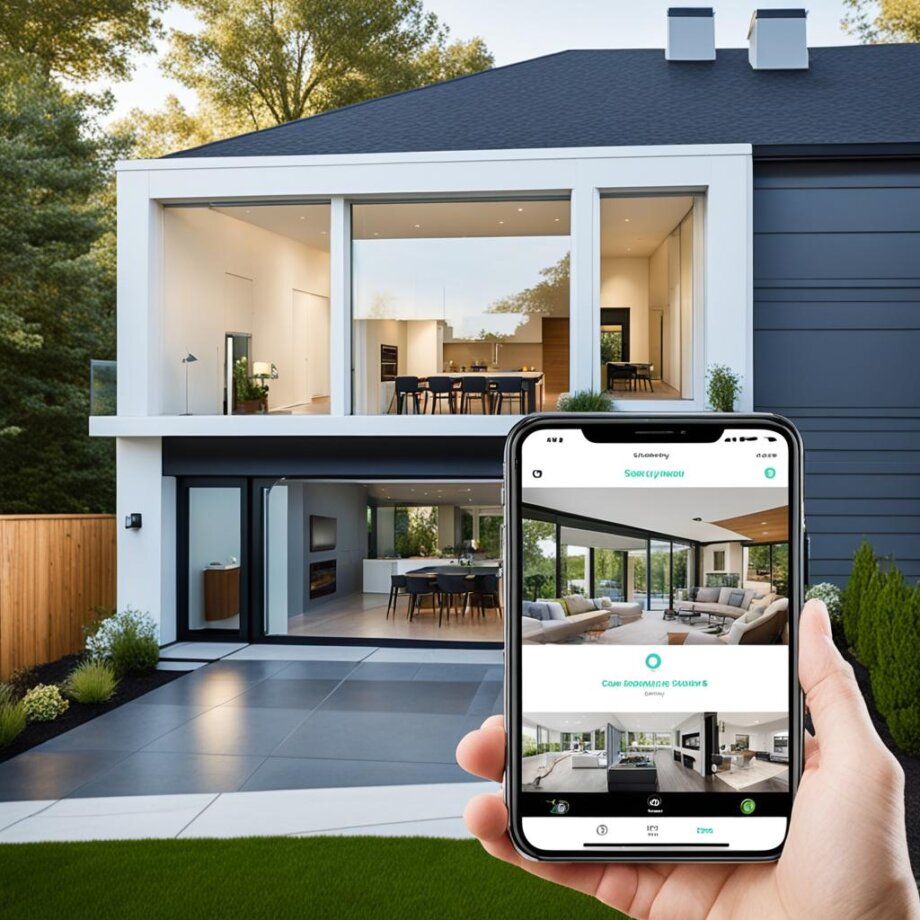
Enhancing Comfort and Energy Efficiency
In today’s fast-paced world, finding ways to enhance comfort and energy efficiency in our homes is more important than ever. With a smart home setup, you can achieve just that. By incorporating intelligent technologies and automation, you can create a living space that adapts to your needs while reducing energy consumption. In this section, we will explore some key elements that can take your home automation to the next level.
Smart Thermostats
One of the most significant contributors to energy consumption in a home is heating and cooling. With a smart thermostat, you can easily control and optimize your home’s temperature, saving energy and money in the process. These intelligent devices learn your preferences and adjust the temperature accordingly, ensuring comfort while reducing waste. Some models even have motion sensors that detect when you’re away, automatically adjusting the temperature to save energy.
Motorized Blinds
Motorized blinds offer a convenient and energy-efficient solution to control natural light and privacy in your home. With the ability to automate opening and closing, you can optimize the amount of sunlight entering your space, reducing the need for excessive artificial lighting. Additionally, motorized blinds can be programmed to adjust based on the time of day, temperature, or your preferred settings, creating a comfortable and energy-efficient environment.
Energy Monitoring Systems
Understanding your home’s energy consumption is key to making informed decisions about efficiency improvements. Energy monitoring systems provide real-time data on how much energy your appliances and devices are using, allowing you to identify areas of high consumption and make necessary adjustments. By being aware of your energy usage patterns, you can take steps to reduce waste and lower your carbon footprint.
With the right combination of smart thermostats, motorized blinds, and energy monitoring systems, you can create a home that maximizes comfort while minimizing energy usage. Imagine a space that automatically adjusts the temperature, lighting, and privacy settings to suit your needs, all while reducing your environmental impact.
By incorporating these elements into your home automation system, you can enjoy improved comfort, convenience, and energy efficiency. Take the next step towards creating your own smart home by exploring the options available and implementing the solutions that align with your lifestyle and sustainability goals.
About the Author:
John Smith is a home automation enthusiast with years of experience in building and customizing smart homes. He is passionate about sharing his knowledge and helping others create their own intelligent living spaces.
| Smart Home Element | Benefits |
|---|---|
| Smart Thermostats |
|
| Motorized Blinds |
|
| Energy Monitoring Systems |
|
*Note: The image above illustrates the integration of smart thermostats, motorized blinds, and energy monitoring systems within a smart home setup, contributing to enhanced comfort and energy efficiency.*
Customizing Control and Integration
Once you’ve set up your home automation system, it’s time to customize the control and integration to suit your preferences. By personalizing your smart home experience, you can automate tasks and control devices with ease, creating a seamless and efficient living environment. Here are some key considerations when customizing control and integration:
1. Voice Assistants:
Utilize voice assistants such as Amazon Alexa or Google Assistant to control your smart home devices using simple voice commands. With voice control, you can easily adjust lighting, set the temperature, and even play music, all without lifting a finger.
2. Mobile Apps:
Take advantage of mobile apps provided by device manufacturers or automation platforms to manage and control your smart home remotely. These apps allow you to monitor security cameras, adjust settings, and receive notifications on your smartphone or tablet.
3. Automation Platforms:
Consider integrating your smart devices into an automation platform, such as Apple HomeKit or Samsung SmartThings. These platforms offer advanced automation capabilities, allowing you to create custom scenes, schedules, and rules for your smart home.
By customizing control and integrating different devices and systems, you can unlock the full potential of your home automation setup. Create a personalized smart home experience that caters to your needs and enhances your daily routines.
With the right customization and integration, your smart home will be a true reflection of your lifestyle, providing convenience, comfort, and energy efficiency. The possibilities are endless when you have the power to create your own smart home.
Conclusion
Congratulations on completing our DIY guide to building a custom home automation system! You have now learned how to create your own smart home from scratch, transforming your living space into a more convenient and efficient environment. By automating your home, you have taken a significant step towards enjoying the benefits of modern technology.
Throughout this guide, we have explored the various aspects of home automation, from understanding the concept and choosing the right devices to setting up a central hub and enhancing network connectivity and security. We have also provided detailed instructions on automating lighting and appliances, creating a smart security system, and enhancing comfort and energy efficiency.
By customizing control and integrating different devices and systems, you can truly create a personalized smart home experience. Now, armed with your newfound knowledge, it’s time to put it into action. Start by planning your home automation project, identifying the specific needs and requirements of your household. Then, follow the step-by-step instructions provided in this guide to bring your vision to life.
With a DIY approach, building a custom home automation system is not only achievable but also incredibly rewarding. Take control of your home, automate everyday tasks, and enjoy the convenience, comfort, and security that a smart home has to offer.

